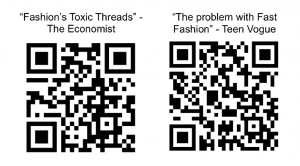We may not purchase our denim jeans often, but their environmental impact is extremely significant. We use a huge amount of water and chemicals to produce denim jeans. 2 billion jeans are produced annually worldwide, and it’s going to take a large-scale sustained effort to make a meaningful change.
Denim was originally made out of wool, but then it shifted to cotton due to trends. However, there are sustainability issues in cotton cultivation and processing. 1500 gallons of water is needed to grow 1.5 pounds of cotton, which is required to produce only a pair of jeans. Denim jeans produce heavy amounts of water, as mentioned above… “cotton, in general, is a very thirsty crop,” says Tatiana Schlossberg, a former environmental reporter at the New York Times. Producing just 1 kilogram (2.2 pounds) of cotton can require up to 7,660 gallons of water, depending on where it’s grown. A cotton crop consumes a lot of chemicals too: 16 percent of all insecticides are used on the plant, and many of them pose significant health risks for farm workers and nearby residents. Denim is usually made with indigo-dyed warp yarn and undyed weft yarn. The indigo dye used was natural and derived from a plant source, but later the trend shifted to synthetic indigo dye. However, as seen from the information below, these dyes pose its own separate environmental pollution threat as well.

Information from Vice (2017)

‘Blue River’ in Xintang, China (The Guardian, 2011)
The signature blue dye, indigofera tinctoria, is used to produce the shade of denim blue in jeans today. According to Vice (2011), an average pair of jeans require half an ounce of dye. However, the problem lies in the production of it. In the denim capital of the world in Xintang, China, this pollutive process is very much evident in the rivers and how the production affects the people working and living in the area. Denim jeans production in Xintang, China accounts for one in every three pairs of jeans sold globally. Because of limited regulatory oversight, by 2013 Xintang’s rivers ran a deep blue and smelled foul, a result of manufacturers dumping chemical-laden wastewater directly into local waterways. The picture above shows the river dyed blue from the release of chemicals to the river from jeans production factories. Unsafe amounts of toxic metals like mercury, lead, and copper has been found in the water, which residents rely on for drinking and bathing. Workers and residents have reported rashes, lesions, and, some locals believe, infertility (Guang et al, 2020). Producing only one pair of jeans requires an immense amount of water, energy, and environmental pollution. Apart from the health of the workers, there are also concerns about drinking water for people living downriver. The East River is the source of drinking water for millions of people living in Guangzhou. This threatens the water security of the cities of Dongguan and Shenzhen.
However, it is to note that there are denim brands and other fashion designers that are taking a more sustainable approach to their manufacturing processes.The majority of these processes are fairly new to the denim manufacturing market. With a more inquisitive mind and rational decision-making mindset whilst purchasing your denim, there is hope to the reduction of environmental pollution from denim.
Here’s a full report by Muthu (2017) on the Sustainability in Denim. Areas covered include Denim’s environmental impact, its water footprint, carbon footprint and many more.
References
Schlossberg, T. (2019, September 03). How Fast Fashion Is Destroying the Planet. Retrieved October 22, 2020, from https://www.nytimes.com/2019/09/03/books/review/how-fast-fashion-is-destroying-the-planet.html
Vice. (2017). Your Jeans Are Ruining the Earth. Retrieved October 22, 2020, from https://www.vice.com/en/article/kzzpjm/your-jeans-are-ruining-the-earth-v24n7
The Guardian. (2011, February 09). The price of success: China blighted by industrial pollution – in pictures. Retrieved October 22, 2020, from https://www.theguardian.com/environment/gallery/2011/feb/09/pollution-china-manufacturing-towns
Guang, L., Mingzhuo, J., & Guang, L. (2020, May 14). The denim capital of the world: So polluted you can’t give the houses away. Retrieved October 22, 2020, from https://chinadialogue.net/en/pollution/6283-the-denim-capital-of-the-world-so-polluted-you-can-t-give-the-houses-away/
Muthu, S. S., & Textile institute. (2017). Sustainability in denim. Duxford, United Kingdom: Woodhead Publishing is an imprint of Elsevier.















